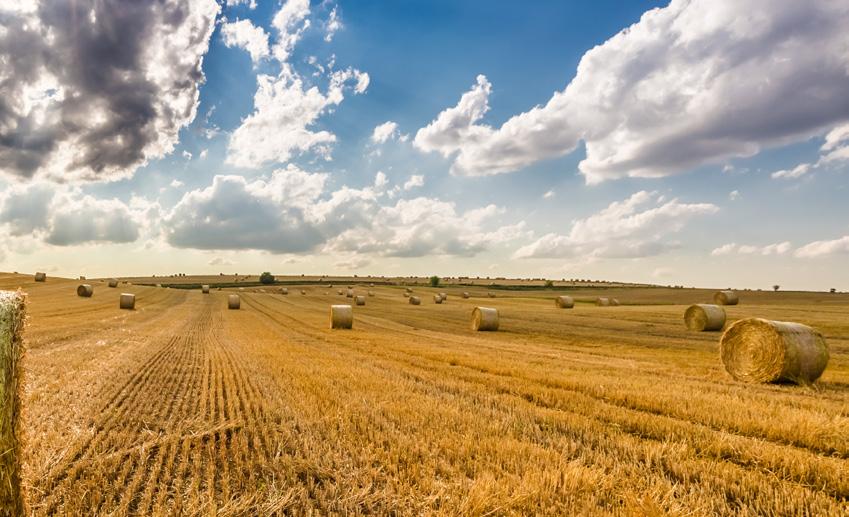AGVIEWS
— BY LYNN PAULSON
Bell Bank Director of Agribusiness Development
AgViews Live Takeaways and Top Issues to Watch This Fall
Have we seen this movie before?
That was the question posed at Bell Bank’s recent AgViews Live seminars, held once again in Fargo, Sioux Falls, and Wisconsin Dells. The 10th annual event drew a record number of ag producers and other attendees from the world of agribusiness to hear from me and Dr. David Kohl, an author and national speaker on agricultural finance and the overall economy. In this edition of AgViews, we look at the top takeaways from this year’s event and discuss some important issues facing the world of agriculture as the calendar flips to fall.
Every year, I always enjoy seeing, hearing from and talking to AgViews Live attendees, who range in age from their early teens to some well into their 90s. Watching this wide range of folks show interest year after year is one of the most satisfying and rewarding aspects of the event. It clearly reinforces that, whether or not we live or work on a farm or ranch, we all have a vested interest and connection to agriculture.
Nolan Keleher attended AgViews Live in Wisconsin Dells with his father, and had this to say:
“I enjoyed the experience and information I was able to take away from this opportunity. I am considering pursuing a degree in finance/ economics, and this gave me some insight into this field.”
Britt Miller, vice president of First National Bank in Philip, S.D., traveled over 250 miles to attend AgViews Live in Sioux Falls and wrote: “It was well worth my time and it was a great investment for my bank. I have attended 15 years of agriculture conferences, spending anywhere from 2-3 days, and this event lasting four hours had more information and knowledge than many of those conferences I have attended.”
Thanks to Nolan, Britt and everyone else who attended this year’s events!
Nolan Keleher and Dr. David Kohl at AgViews Live
Tips for Managing Through Challenges
At this year’s AgViews Live, Dr. Kohl and I discussed how current conditions in parts of the agricultural economy are starting to feel similar to the years following the last super cycle, which ended in 2013. At the time, producers faced lower prices, but without the added stress of high interest rates or higher costs. Now, prices are once again low, but input costs and interest rates are both up. Despite the economic headwinds many ag producers may be facing, recent highly profitable years coupled with record farmland values put most ag producers in a strong financial position going into this expected downturn.
To manage through these challenges, Dr. Kohl and I stressed the importance of heeding lessons learned a decade ago, some of which included:
✔ Pay close attention to your financials. Know your cost of production and breakeven points, monitor your cash flows, and have a banker you can trust and lean into when times are tough.
✔ If you need to refinance to rebuild your liquidity, “Make sure you’re building a bridge to financial stability rather than a pier that just takes you out into deep water where you drown in additional debt,” said Dr. Kohl.
✔ Set goals for yourself. Goal setting is an important practice for when times are tough. According to some figures, 80 percent of Americans have no goals, 16 percent have goals but only have them in their head, and only 4
percent have actually written their goals down. Take the time to develop both your short-term and long-term goals, which can help you stay focused when obstacles arise.
✔ Similarly, model potential scenarios for your business. Look at all possibilities, including best-case, middle and worst-case scenarios. This can help you be prepared no matter what happens.
✔ Being successful is often not about doing one big thing better – rather, it’s about being 5% better in a number of key areas.
I recently joined host Peggy Coffeen on an episode of the Uplevel Dairy podcast to discuss AgViews Live and some of the most important issues in ag.
it
Takeaways and Fall Topics to Watch
This summer’s AgViews Live also touched on many other important issues facing agriculture today. Here are some of my top takeaways from this year’s events that are worth watching as we move into fall.
FARMLAND TRENDS AND LAND VALUES
Land values have likely peaked, but there will still be some high outlier sales. Additionally, values seem to be becoming a bit more regionalized. There’s going to be a huge intergenerational transfer of wealth, including farmland, in the next couple of decades – some reports estimate around $70 trillion to $80 trillion of wealth will be transferred, with around $4 trillion of that total being farmland. As a result,
there will likely be an increased supply of land coming on the market in the next few years. That, combined with a more challenging farm economy and higher interest rates, may keep the lid on rising land values.
STRONG HEADWINDS IN THE AG ECONOMY – PARTICULARLY IN THE GRAIN SECTOR
As previously noted, the farm sector is currently in a strong financial position after a number of profitable years. That
said, there’s potentially a reason for concern on the horizon. While there’s a lot of horsepower (net worth) in the ag sector, you still need fuel (cash flow and profits) to make the engine run. The latter may be harder to come by over the next few years.
Commodity prices that are below most producers’ breakeven points, a slowing demand for commodities, higher interest rates, and expenses that aren’t declining all contribute to margin compression. Interestingly, it seemed that
at all three AgViews Live events, bankers were perhaps more concerned than producers about current headwinds. This is probably not surprising given that producers are in their busiest time of the year and are locked into taking care of crop production details, but the economic realities will ultimately need to be addressed.
Other things to note when it comes to these headwinds: It’s important to watch your leverage with higher rates, especially with carryover debt and potential refinances. Also, keep an eye on softening machinery and equipment values. For the younger generation, paying attention to the changing economic landscape will be key. Many younger producers have not yet experienced really bad years in their farming careers.
THE IMPORTANCE OF WORKING CAPITAL OR LIQUIDITY
If you have working capital or liquidity, how do you maintain it? If you don’t, do you have a plan to replenish it? One can’t overemphasize the value and importance of managing this area. Businesses don’t usually fail because they go broke or are insolvent – they fail because they run out of cash (working capital/liquidity) and lose the ability to meet short-term obligations.
opportunity to disrupt trends because they don’t have to deal with the same limitations and layers of bureaucracy.
FARM BILL/POLITICAL FRONT
There isn’t a real consensus on when a new farm bill will be passed – or what will change once it is passed. There seems to be a limited opportunity for additional funding for new programs. The number one priority will be to protect crop and livestock insurance programs and the safety net they provide.
Watch for developments related to the recent Supreme Court ruling reversing the Chevron Doctrine as it relates to future regulations in agriculture and who has the power to enforce them. With respect to the outcome of the upcoming U.S. elections, compromise and bipartisan agreement may continue to be difficult to find, making any meaningful legislation hard to come by. Speaking of politics, 50 percent of the world’s population is holding elections in 2024, and the results could have a meaningful impact on the world of agriculture in the years to come.
GLOBAL CONSIDERATIONS
RECORD DEFICITS
Record deficits in the U.S. and around the world – and the interest costs of those deficits – will eventually need to be dealt with. The current paths are simply not viable in the long term. Also, keep an eye on increasing credit card debt ($1.3 trillion and growing) along with delinquencies in credit card and other consumer debt. The philosophy of ignoring these unsustainable trends with the attitude that “the government will take care of me” may be short-sighted.
WEATHER/STRESS
As I mentioned in our last newsletter, the wet spring in many areas was a good reminder that Mother Nature is still very much in charge. Because of lower commodity prices, producers need bushels to offset lower prices. With economic headwinds, higher stress levels can be an unfortunate byproduct. Don’t lose sight of the fact that farming and ranching are still terrific businesses to be in and great places to raise a family. We just need to remember to manage stress levels and focus on what we can control.
LIVESTOCK
LONG-TERM EFFECTS OF CONSOLIDATION
We’re seeing more and more consolidation in the world of ag producers and agribusinesses. While the long-term impact of this trend remains to be seen, the increase of larger companies and economies of scale may mean a loss of creativity and innovation. This can open the door for small businesses and entrepreneurs, who may have an
As I’ve touched on before, what happens in China and Brazil continues to be worth watching. China is dealing with demographic and economic issues that have ramifications for the U.S., while Brazil’s agricultural economy is becoming more and more competitive on the world stage. As Brazil builds out its infrastructure and moves more farmland into production, we’ll be seeing some strong competition from the southern hemisphere.
It’s a great time to be in most parts of the cattle business. The outlook continues to be largely favorable, with strong demand for beef and relatively tight supply. Furthermore, the industry doesn’t seem to be in any hurry to rebuild the cow herd, which should be advantageous for longer-term prices – especially for cow/calf producers. Consumer preferences, stress of the general economy, biosecurity and other macroeconomic factors could contribute to some moderate headwinds.
Balancing Act: Tips for Upholding Family Farm Traditions Without Affecting Farm Management
I’ve seen firsthand how farm traditions can drive feelings and motivations, and provide purpose to many.
—Don Lacey
Growing up on and helping manage a family farm near Wendell, Minn., I’ve experienced a thing or two about family farm traditions and how they can impact family farm management. In my decade of managing my family farm’s operation, and in my several years of working with ag producers at Bell, I’ve seen firsthand how farm traditions can drive feelings and motivations, and provide purpose to many. And I’ve seen how those traditions can spill over into everyday management decisions. This can be a good thing when it helps provide direction, but there are also times when it can create conflict and tension on the farm.
This can happen in a number of different ways. Maybe a child moves back home to help out with a parent’s farm operation, for example, only to find that things on the farm and at home are still being done the same way and their parents don’t want to change. Or maybe the child finds they don’t have any privacy in the new living arrangements, or they find there’s no separation between family and farm business.
Whatever the situation, differences in values or expectations can put a strain on the family relationship when they’re not addressed. On a family farm, there are a limited number of boundaries or guardrails in place between the family and the business, and when there’s tension in farm relationships, Sunday dinner may not taste the same.
Here are a few tips to consider to help manage the many different hats that family farm operators wear on a daily basis, and to keep traditions from negatively impacting the management of the farm:
1
Identify and communicate personal and operational strengths and weaknesses for everyone involved in the business. Don’t be afraid to share this information with all stakeholders to help backfill any weaknesses or further improve strengths.
2
Identify and articulate operational roles. Formalize everyone’s role and what their responsibilities are, regardless of the size of the operation. It’s important to put pen to paper to articulate what those roles are – this may help those “in charge” manage expectations instead of managing people or the process, which could help diffuse or avoid conflict.
3
Consider mentoring the next generation by allowing them to have input on major decisions before sharing your own thoughts. On the other end, younger producers should ask lots of questions and lean on the knowledge of the managing generation, and be ready to step in when needed.
4
Hold regular meetings during your “business hours.” This may vary by operation, but consider holding weekly check-ins in addition to monthly reporting, quarterly business meetings, and annual reviews. Make sure these occur during a weekday rather than around the family table on the weekend.
5
Establish and communicate a clear mission statement, vision and core values of the business, and revisit them annually. Do your personal goals reflect that broader mission, vision and core values? Are the goals shared by everyone in the family business, or do they need to be adjusted? Also consider any off-farm siblings and spouses for the above points. Have the mission statement, vision or core values been shared with them? Do they want to be part of the legacy or tradition?
6
Seek information continuously. I’ve participated in our family’s farm operation since I was old enough to walk and talk, and if there’s one thing I’ve learned from my time in the ag industry, it’s the willingness of others to share pretty openly what works and what doesn’t. Use the tools that are available to you, like social media, to find and follow trusted voices in ag. Get in touch with continuing education and peer group opportunities – the Executive Program for Ag Producers out of Texas A&M is one example that can help you connect and consult with someone who may have family dynamics or financial situations similar to your own.
Managing outcomes on a family farm can be difficult because of factors like weather, pricing and regulations. Family businesses don’t need the added stress of conflict and tension to make things even more challenging. By following these tips, you can maintain your boundaries, manage expectations, and uphold family traditions without negatively affecting your daily operations.
If you’re ready to talk about your farm financing, call an experienced Bell Bank ag lender in your area. We’re proud to serve American farmers and agribusinesses!
Our roots run deep. Bell has the area’s longest-serving group of lenders, with more than a century of experience among them. We understand that as the business of farming becomes ever more complex each year, you need a lender who understands that challenges are opportunities for success.
We have money to lend. Find greater stability from season to season with a long-term loan, or use shorter-term loans to increase cash flow to your farming operation.
lpaulson@bell.bank
Lynn is Bell’s director of agribusiness development. He writes and speaks about agricultural lending and finance, the global economy and the ag economy.
He has expert knowledge of the ag industry, having worked in ag lending for more than 30 years and as a retired owner and operator of a Benson County, N.D., family farm. His banking experience includes merging several banks and holding companies and growing the new company to $600 million. He has also served on various financial boards.








































































































































































































































































